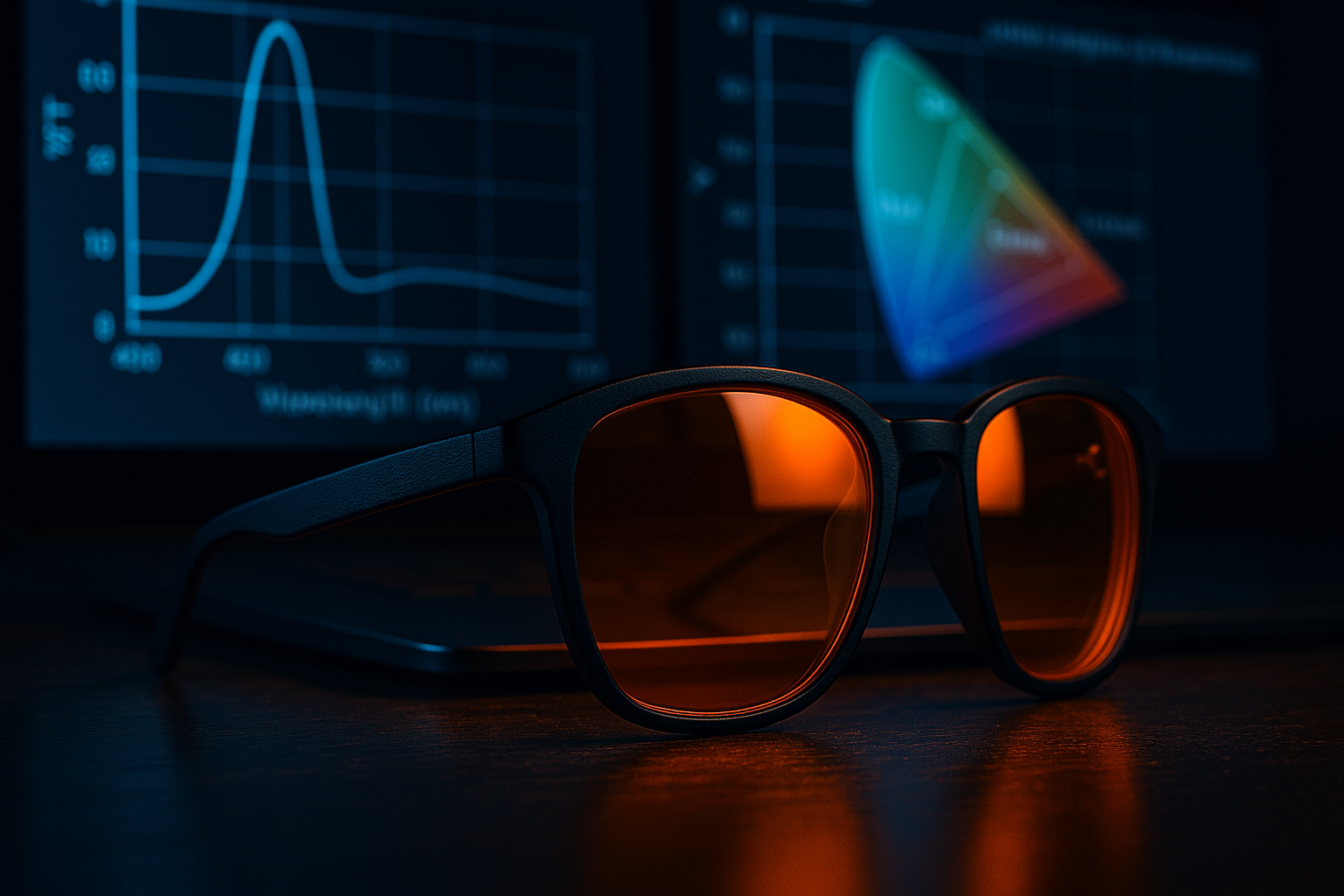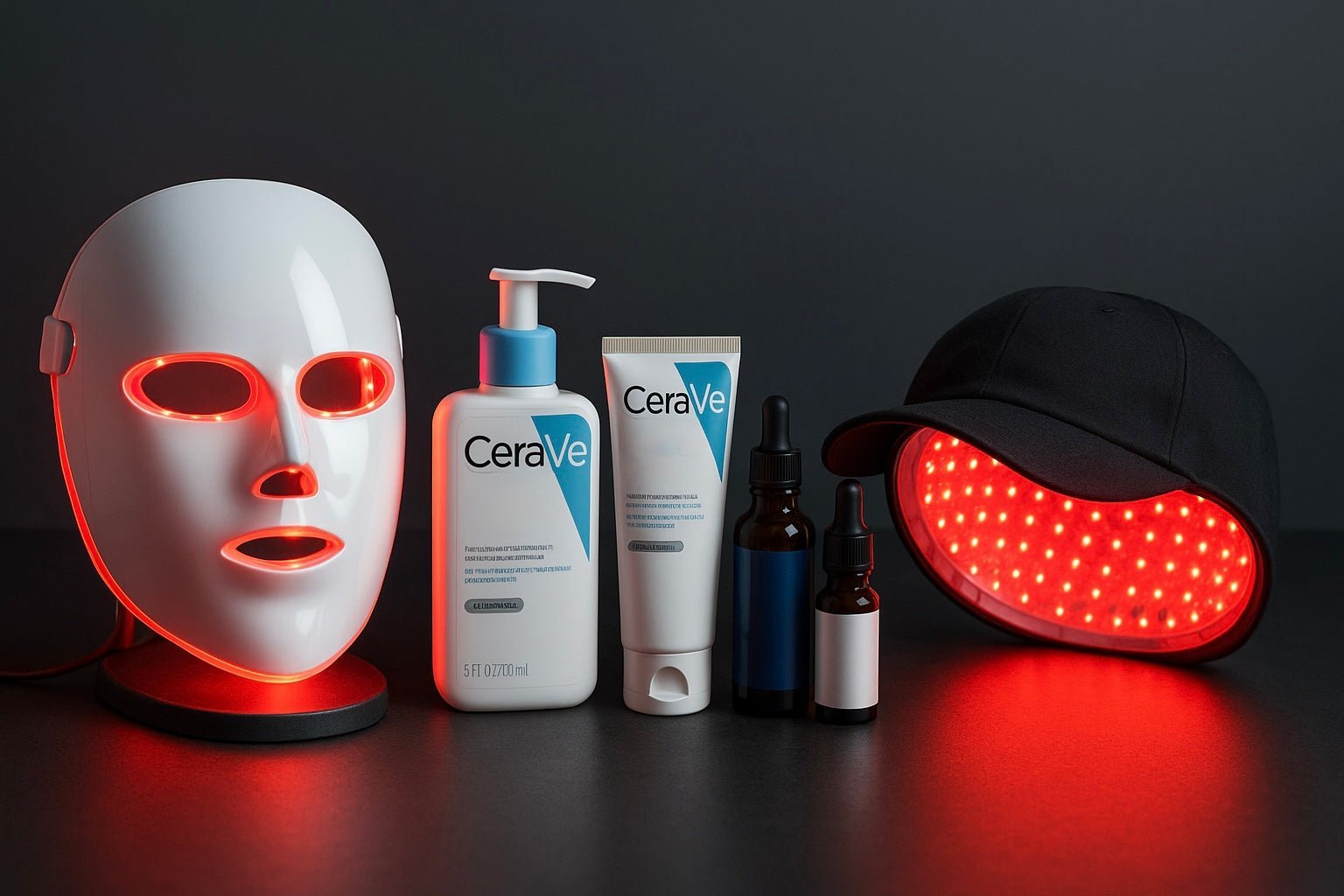The Real Science Behind Blue Light Blockers: What Your Lenses Actually Do

Blue light glasses exploded in popularity over the last decade, but most people still have no idea what they actually block, how they’re tested, or why some lenses work far better than others. Screens, LEDs, and even indoor bulbs all emit specific wavelengths of light that affect our brain, hormones, and sleep—and the color of the lens determines which wavelengths are filtered out.
Recently, we ran full lab testing on our red/orange night-use lenses. The results give a very clear picture of how true blue-light blockers behave in the real world—and what those numbers actually mean for your eyes, your mood, and your sleep.

Let’s break it all down!
🔬 What the Test Measures: Wavelength by Wavelength
Light is measured in nanometers (nm). Different wavelengths affect the body in different ways:
- 280–380 nm: UVB + UVA (can damage skin and eyes)
- 380–500 nm: Blue light (controls alertness, melatonin suppression)
- 500–560 nm: Green light (also suppresses melatonin)
- 560+ nm: Yellow, orange, red (mostly harmless to sleep)
The lab analyzed exactly how much light passes through the lenses at each wavelength. The lower the percentage, the better the blocking.
🔵 1. Extreme Blue Light Protection (380–500 nm)
The lenses blocked ~98% of all blue light across the entire blue-light range.
Here are the exact numbers:
- 380 nm: 0.59% transmission
- 390 nm: 2.99%
- 400 nm: 11.26%
- 420–490 nm: generally 1–4%
This is the range that suppresses melatonin the most strongly, especially between 446–477 nm, where the melanopsin receptors in the eye are most sensitive.
Blocking this range means:
- Your brain produces melatonin normally
- Your circadian rhythm stays stable
- Eye strain decreases
- Night-time overstimulation drops
This is why red/orange lenses feel instantly calming.
🟢 2. Strong Green Light Reduction (500–550 nm)
Many people don’t know this, but green light also suppresses melatonin, although not as powerfully as blue.
Your lenses block 90–95% of light up to ~550 nm.
That includes:
- 500 nm → ~3.82% transmission
- 520 nm → ~7.91%
- 530 nm → 15.22%
After ~540–550 nm, transmission increases (as expected), which keeps the world visible so you’re not walking around in the dark.
This is a very good green-light reduction profile for night-time use.
🌞 3. Complete UV Blocking (280–380 nm)
The lenses also completely eliminate ultraviolet light:
- UVB (280–315 nm): 0.00%
- UVA (315–380 nm): 0.00–0.12%
This is typical for high-quality optical coatings, but it’s still great to see verified.
🧠 Why These Ranges Matter for Your Brain
Blue Light (especially 440–480 nm)
Triggers melatonin → signals “daytime” → stops melatonin.
Green Light (500–550 nm)
Affects a different but related pathway in the retina that also delays melatonin release.
Studies show that even dim green light can keep you awake, while red/orange wavelengths do not.
So the test confirms the lens does exactly what a night lens should:
✔ Blocks the entire melatonin-suppression zone
✔ Lets through only wavelengths that don’t interfere with sleep
👁️ Why They Don’t Block All Light
If a lens blocked everything below 560 nm with 100% efficiency, you wouldn’t be able to see much indoors.
You’d basically be walking around with sunglasses in a dark room.
The small amount of green passing through (mostly above 520–530nm) keeps:
- Shapes visible
- Colors recognizable
- Navigation safe
- Screens readable without strain
Night lenses need to balance biological function with practical usability — and the test shows these lenses do exactly that.
📱 What This Means in Real Life
Practical benefits
- Your eyes relax almost instantly
- Screen glare is massively reduced
- Melatonin builds normally in the evening
- Your circadian rhythm isn’t disrupted by LED lighting
- Sleep onset becomes easier
- You wake up with less “tired eyes” feeling
When to wear them
- 1–3 hours before bed
- While using screens at night
- In bright indoor lighting
- In environments with LED/fluorescent bulbs
- Any time you want to wind down
When NOT to wear them
- While driving at night (they block too much blue/green for safe color recognition)
🎯 Bottom Line
The lab results show that these lenses are doing exactly what true circadian-rhythm night blockers are supposed to do:
- ~98% blue light blocked
- Strong green light reduction up to ~550 nm
- Nearly total UV protection
- Only minimal higher-green transmission to keep the world visible indoors
They target all the wavelengths that affect sleep biology, without turning the world pitch black.
It’s the kind of blocking profile you want if your goal is better sleep, easier wind-down, and less night-time eye strain — backed by measurable, wavelength-by-wavelength data.


